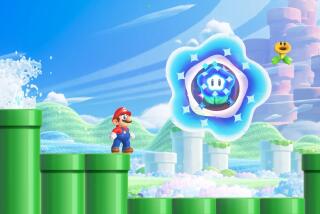OC HIGH / STUDENT NEWS & VIEWS : video game review : Yoshi’s Safari : <i> From Nintendo for SNES, $39.95 </i>
- Share via
Time to blow the dust off your Nintendo Super Scope.
Yoshi’s Safari is the latest on a short list of games designed for the gray, bazooka-like gizmo that lets you use your television set for target practice.
The premise is pretty simple. Jewelry Land, so named for the 12 magic gems that protect the peaceful kingdom from harm, is ruled by King Fret and his royal offspring, Prince Pine.
But one day, Bowser and the Koopalings (you’ll remember them from previous run-ins with Mario and his pals) kidnap both rulers and swipe the jewels. The resulting earthquake splits the kingdom in two. Princess Peach, Pine’s sweetie, sends out a call for help.
Mario and Yoshi, his domesticated dinosaur, answer the bell. Their job is to find the 12 gems and set the prisoners free.
Mario hops on Yoshi and they set off through 12 stages to face the worst that Bowser’s baleful band can throw at them.
And that’s where the Super Scope comes in.
Instead of jumping on bad guys or throwing things at them in normal Mario fashion, you use the Super Scope to blast enemies from the screen.
Make no mistake, the action is fast and furious, with airborne assaults coming from all sides and creeping, crawling beasties snapping at Yoshi’s toes almost nonstop.
But once you get your sights set, a process you can repeat as often as you like by pausing the game, keeping the Super Scope moving and firing will limit damage to the plucky pair to a minimum, while you rack up points and coins.
Those coins are important. As in most Mario games, collecting a certain number, in this case 60, gives you an extra life. Miss a jump point, where you must loft Yoshi over a gap in the trail, and you lose three coins.
The game screen provides important information. In addition to keeping track of the coins and lives and watching the clock timing each stage, you should pay attention to the power gauge. The Super Scope fires very rapidly until the gauge drops; as it does, the time between shots gets longer and longer.
That’s bad, because the enemies come in swarms and you need all the firepower you can get. Fortunately, the gauge recharges quickly and, after playing for a while, you learn to time your bursts to do maximum damage while allowing the gauge to refill between attacks.
In a two-player game, one player uses the Super Scope to blast enemies while the second player uses a standard controller to maneuver Yoshi. In a one-player game, Yoshi is computer-driven.
This is the first Super Scope title to use Nintendo’s Mode 7 graphics, which allow a full 360-degree perspective and lend a realistic 3-D effect to the action.
It works. Graphics are excellent, enhanced by the palette of pastels used to color the game.
*
Remember the flap a few months ago when Mortal Kombat was released, complete, at least in the Sega version, with the spine-ripping, skull-popping death moves of the arcade original?
It raised again the question of how to make an informed decision on what games to buy.
Find a need and fill it, says Infotainment World, publishers of GamePro, one of the more popular magazines dedicated to video games. They have begun a bimonthly, 16-page newsletter called PlayRight to help make those decisions.
In addition to advice on which games are best for each age group, PlayRight will discuss such issues as how to regulate time spent at the controls, whether a rating system such as Sega’s is worthwhile and how video game violence affects young people.
More to Read
The biggest entertainment stories
Get our big stories about Hollywood, film, television, music, arts, culture and more right in your inbox as soon as they publish.
You may occasionally receive promotional content from the Los Angeles Times.










